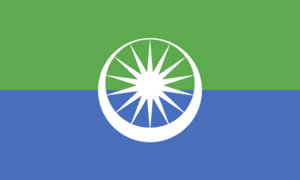New Kanbon
The Viceroyalty of New Kanbon | |
|---|---|
|
Flag | |
| Capital and largest city | Kan Bon Zen |
| Official languages | Kanbonese |
| Recognised national languages | Isrudi Kanbonese |
| Recognised regional languages | Preung, Khotar, Tarrgein |
| Ethnic groups (2403) | Isrudi Kanbonic, Kanbonic, Khotar, Tarrgeini |
| Demonym(s) | New Kanbonese |
| Government | Colony |
| Legislature | The Central Government |
| A colony of Kanbon | |
• Settlement of Isrudi by Kanbonese | 700 PL |
• Fall of the New Kanbonese Kingdom | 1250 PL |
• Controlled by Khotar rulers | 1450 - 1820 PL |
• Resettlement of New Kanbon | 1950 PL |
| Population | |
• 2412 census | 15.3 million |
• Density | 7/km2 (18.1/sq mi) |
| HDI (2410) | 0.432 low |
New Kanbon is the name of the colonial government in Isrudi, controlled by Kanbon. It is composed of many #Provinces, and other types of autonomous regions, including the #Great Province of New Kanbon , the #Bayfort Directorate, and #Crownland owned directly by the viceroy.
The head of the New Kanbonese government is the Governor-General. He has legislative and executive power over all of New Kanbon.
History
Settlement
New Kanbon, a colonial nation situated on the continent of Isrudi, emerged as a prominent settlement during the height of the First Kanbonese Kingdom around 700PL. This historical period witnessed a significant influx of colonists who ventured to various coastal regions, where they established thriving cities that continue to endure through the passage of time.
In a significant development around 800PL, the Kanbonese crown, recognizing the strategic importance of New Kanbon, appointed a viceroy to oversee the region. This viceroy assumed the responsibility of representing and safeguarding the interests of the Kanbonese crown in this burgeoning colony, effectively establishing a direct link between the colonial administration and the reigning monarch.
However, the influence exerted by the Kanbonese crown over New Kanbon during this era was notably limited due to the absence of advanced maritime technologies. The absence of such innovations resulted in extended travel times, impeding effective communication and governance between the colonial authorities and the motherland. Consequently, the Kanbonese yoke was considerably weakened, providing a certain degree of autonomy to the inhabitants of New Kanbon during this phase of its history.
Decline and fragmentation
In the year 1010PL, the First Kanbonese Kingdom succumbed to the onslaught of invading forces, resulting in a profound shift in the political landscape. With the fall of the kingdom, the influential patronage of the crown, which had hitherto provided crucial support to the colonists, was abruptly terminated. Consequently, the inhabitants of New Kanbon found themselves bereft of the protective shield that the crown had afforded them, leaving them vulnerable and exposed to external threats.
During this period of upheaval, the rise of the Third Gehani Empire brought about significant territorial changes and power shifts in the region. The ascendancy of the empire forced numerous Khotar tribes to relocate southeastward, seeking refuge from the encroaching forces. Many of these displaced tribes migrated to Kanbonese lands, instigating the destruction of numerous villages that previously dotted the landscape.
The culmination of these turbulent events manifested in the disintegration of New Kanbonese authority by the year 1250PL. The once-unified nation fractured into autonomous city-states, each compelled to fend for itself amidst the chaotic aftermath of political collapse.
Subsequently, the Khotar peoples persisted in their march and continued to invade the remaining Kanbonese city-states. Notably, the coastal regions remained the sole bastion under Kanbonese control, as the inhabitants valiantly defended their territories against the encroaching forces, seeking to preserve the last vestiges of their waning authority.
